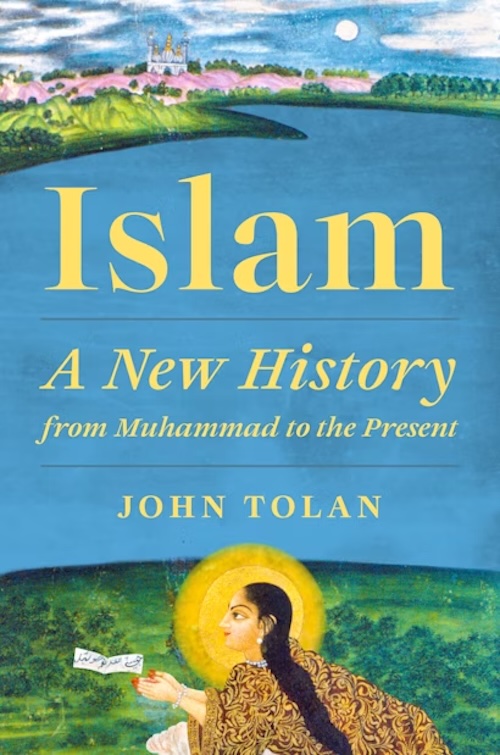A Review of Islam: A New History, from Muhammad to the Present (Princeton University Press, 2025) by John Tolan
Detroit (Special to Informed Comment; Feature) – Islam has had a major influence on the world as a religion, a culture and a civilization. As a religion, Islam is based on two main sources: the Quran and collections of the sayings and actions of Muhammad (hadith). It is a faith cherished by nearly 2 billion believers around the world. As a culture and a civilization, global Islam has developed and evolved over fourteen centuries, shaped by rapid expansion beyond Arabia through conquest and conversion, as well as by brilliant inventors, scientists, intellectuals, architects and builders.
The long history of Islam is the subject of John Tolan’s delightfully readable book, Islam: A New History, from Muhammad to the Present (Princeton University Press, 2025). Tolan is a distinguished scholar and the author of Faces of Muhammad (Princeton University Press, 2019), Saint Francis and the Sultan (Oxford University Press, 2009), and Saracens (Columbia University Press, 2002). He aims to bring recent scholarship on the history of Islam to a broad audience of non-specialists and to show “the complexity and diversity of Muslim civilization.”
Tolan starts by looking at the foundations of Islam in 7th century Arabia. He acknowledges the sharp debate among historians over many aspects of the traditional narratives of Islam and accounts of the life of Muhammad. “It is difficult, often impossible” he writes, “to separate historical facts from pious legends, biography from hagiography.” But Tolan considers the Quran as “the only important document from the first century of Islam and the best source for understanding the life of Muhammad and his companions in Mecca and Medina.”
Islamic civilization was established through conquests in the Near East, North Africa, Iberia and Central Asia. Tolan demonstrates how imperial Islam asserted its power and authority over vast territories, but it did not bulldoze or erase other cultures or religions. In fact, it lifted geographical and social partitions between people, produced great art, architecture, science, literature, and inspired new ideas. During the illustrious Abbasid Empire in the ninth and tenth century, Muslim, Jewish and Christian scholars studied and debated texts and ideas side by side in Baghdad. Tolan states that “Muslim law in the Abbasid period was formed by a fusion of Arab, Persian, Roman, Christian, and Jewish legal practices and texts, in addition to strictly Muslim elements (Quran and hadith).”

John Tolan, Islam: A New History (Princeton: Princeton University Press, 2025). Click here to buy.
Islamic civilization was at its creative best when it shunned dogmatism, encouraged dialog and exchange and worked with other traditions to build a humane and ethical society. A good example is the Mughal dynasty which did not rule India with an iron fist. Tolan says that the Mughals “worked to create a modus vivendi with non-Muslims (Hindus, Buddhists, Christians, and others).” Islamic civilization did not create perfect utopias of equality, tolerance, and coexistence, including in Muslim Spain (Al-Andalus), which has been crowned as the “Golden Age” of Islam. However, there are bright, shining moments of progress and enlightenment in the history of Islam, when Muslims worked cooperatively with others to transform their societies and the world.
Islamic civilization faced enormous internal and external threats through power struggles, invasions, and wars that weakened the defenses of empires until they collapsed and disintegrated. The dissolution of the once powerful Ottoman Empire (1299-1922) and its caliphate marked “the abandonment of Muslim universalism,” according to Tolan. He notes that while some Muslims have called for the restoration of the caliphate, “others welcomed the liberation of Muslims from this outdated institution.” What followed was the rise of secular states, nationalism and political Islam.
Tolan highlights the important role of Sufis and women in Islamic history. To counter simplistic stereotypes about Islam as a violent, provincial, and oppressively patriarchal religion, he chose an Indian miniature of Rabia al-Adawiyya (716-801 CE), a famous Sufi mystic from Iraq, to grace the cover of his book. He says it “gives us a completely different image of Islam: an image of peace and contemplation, appreciation of the beauty of the world and trust in God.”
Tolan’s book is excellent and a pleasure to read. He lays out the twists and turns in the story of Islam, which is an epic history of unity and division, victory and defeat, expansion and retreat, and change and continuity. Anyone who opens this book with preconceived notions about Islam will think differently when they finish the last page. He reminds us that “the history of Islam refutes all the caricatures that one tries to impose on it.” Tolan deserves praise for offering this book for us to ponder.
.


 © 2025 All Rights Reserved
© 2025 All Rights Reserved